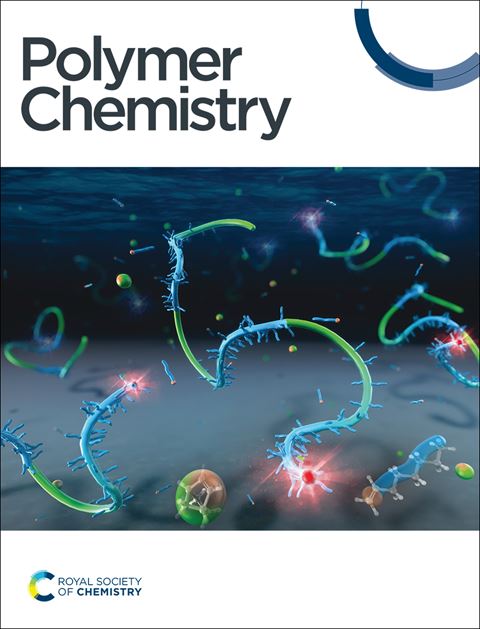烷基硼和多种路易斯碱催化一锅共聚和酯交换法制备PPC-P-co-PLA多嵌段共聚物
IF 3.9
2区 化学
Q2 POLYMER SCIENCE
引用次数: 0
摘要
二氧化碳(CO2)已被用于合成生物可降解聚合物,以促进可持续节能和减少排放。然而,非晶态co2基聚酯-聚碳酸酯(PPC-P)的玻璃化转变温度低,严重阻碍了其实际应用。本文以环氧丙烷(PO)、邻苯二甲酸酐(PA)和CO2与PLA为原料,通过Lewis酸碱对催化酯交换反应,在一锅一步法下成功合成了半结晶共聚物PPC-P-co-PLA。首次利用无金属催化剂同时催化开环共聚和酯交换反应合成共聚物。三乙基硼烷(TEB)/Lewis碱催化聚乳酸酯交换反应机理研究表明,聚乳酸的有效解聚和酯交换反应取决于Lewis碱诱导的α-H化学位移变化。Lewis酸碱对通过连续的酯交换反应将PPC-P的一端与PLA段终止,从而促进PPC-P-co-PLA多嵌段共聚物的形成。与PPCP相比,共聚物的玻璃化转变温度提高了5-7℃,热分解温度提高了18-45℃。在PLA浓度为8wt %时,PPC-P-co-PLA多嵌段共聚物的力学和流变性能达到最佳。本研究为高玻璃化转变温度的半结晶聚酯-聚碳酸酯基共聚物的合成开辟了新的途径,丰富了嵌段共聚物的合成理论基础。本文章由计算机程序翻译,如有差异,请以英文原文为准。
Innovative synthesis of PPC-P-co-PLA multi-block copolymers via one-pot copolymerization and transesterification catalysed by alkyl boron and diverse Lewis bases†
Carbon dioxide (CO2) has been utilized for synthesizing biodegradable polymers to promote sustainable energy conservation and mitigate emissions. Nonetheless, the low glass transition temperature of amorphous CO2-based polyester–polycarbonate (PPC-P) significantly impedes its practical application. Herein, semi-crystalline copolymers, PPC-P-co-PLA, were successfully synthesized via copolymerization of propylene oxide (PO), phthalic anhydride (PA), and CO2 in combination with PLA through transesterification catalysed by Lewis acid–base pairs in a one-pot/one-step method. Metal-free catalysts were utilized for the first time to catalyse both ring-opening copolymerization and transesterification reactions for copolymer synthesis. The mechanism study of PLA transesterification catalysed by triethyl borane (TEB)/Lewis bases revealed that effective depolymerization and transesterification of PLA hinge on α-H chemical shift alterations induced by the Lewis bases. Lewis acid–base pairs facilitate the formation of PPC-P-co-PLA multi-block copolymers by terminating one end of PPC-P with PLA segments via continuous transesterification reactions. Compared to PPC-P, the copolymers exhibit an increase in glass transition temperature by 5–7 °C and an elevation in thermal decomposition temperature by 18–45 °C. The optimal mechanical and rheological properties of PPC-P-co-PLA multi-block copolymers are achieved at a PLA concentration of 8 wt%. This study opens new avenues for the synthesis of semi-crystalline polyester–polycarbonate-based copolymers with high glass transition temperatures, thereby enriching the theoretical foundation for the synthesis of block copolymers.
求助全文
通过发布文献求助,成功后即可免费获取论文全文。
去求助
来源期刊

Polymer Chemistry
POLYMER SCIENCE-
CiteScore
8.60
自引率
8.70%
发文量
535
审稿时长
1.7 months
期刊介绍:
Polymer Chemistry welcomes submissions in all areas of polymer science that have a strong focus on macromolecular chemistry. Manuscripts may cover a broad range of fields, yet no direct application focus is required.
 求助内容:
求助内容: 应助结果提醒方式:
应助结果提醒方式:


